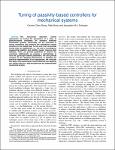Tuning of Passivity-Based Controllers for Mechanical Systems
| dc.contributor.author | Chan-Zheng, C | |
| dc.contributor.author | Borja, P | |
| dc.contributor.author | Scherpen, JMA | |
| dc.date.accessioned | 2023-04-20T12:47:52Z | |
| dc.date.available | 2023-04-20T12:47:52Z | |
| dc.date.issued | 2023-03-31 | |
| dc.identifier.issn | 1063-6536 | |
| dc.identifier.issn | 1558-0865 | |
| dc.identifier.uri | https://pearl.plymouth.ac.uk/handle/10026.1/20733 | |
| dc.description.abstract |
This article describes several approaches for tuning the parameters of a class of passivity-based controllers for standard nonlinear mechanical systems. In particular, we are interested in tuning controllers that preserve the mechanical system structure in the closed loop. To this end, first, we provide tuning rules for stabilization, i.e., the rate of convergence (exponential stability) and stability margin (input-to-state stability). Then, we provide guidelines to remove the overshoot. In addition, we propose a methodology to tune the gyroscopic-related parameters. We also provide remarks on the damping phenomenon to facilitate the practical implementation of our approaches. We conclude this article with experimental results obtained from applying our tuning rules to a fully actuated and an underactuated mechanical system. | |
| dc.format.extent | 1-0 | |
| dc.publisher | Institute of Electrical and Electronics Engineers (IEEE) | |
| dc.subject | Tuning | |
| dc.subject | Mechanical systems | |
| dc.subject | Stability criteria | |
| dc.subject | Closed loop systems | |
| dc.subject | Asymptotic stability | |
| dc.subject | Standards | |
| dc.subject | Damping | |
| dc.subject | Passivity-based control (PBC) | |
| dc.subject | robot control | |
| dc.subject | performance | |
| dc.subject | stability of nonlinear systems | |
| dc.title | Tuning of Passivity-Based Controllers for Mechanical Systems | |
| dc.type | journal-article | |
| dc.type | Article | |
| plymouth.author-url | https://www.webofscience.com/api/gateway?GWVersion=2&SrcApp=PARTNER_APP&SrcAuth=LinksAMR&KeyUT=WOS:000967269000001&DestLinkType=FullRecord&DestApp=ALL_WOS&UsrCustomerID=11bb513d99f797142bcfeffcc58ea008 | |
| plymouth.issue | 6 | |
| plymouth.volume | 31 | |
| plymouth.publisher-url | http://dx.doi.org/10.1109/tcst.2023.3260995 | |
| plymouth.publication-status | Published | |
| plymouth.journal | IEEE Transactions on Control Systems Technology | |
| dc.identifier.doi | 10.1109/tcst.2023.3260995 | |
| plymouth.organisational-group | |Plymouth | |
| plymouth.organisational-group | |Plymouth|Faculty of Science and Engineering | |
| plymouth.organisational-group | |Plymouth|Faculty of Science and Engineering|School of Engineering, Computing and Mathematics | |
| plymouth.organisational-group | |Plymouth|REF 2021 Researchers by UoA | |
| plymouth.organisational-group | |Plymouth|Users by role | |
| plymouth.organisational-group | |Plymouth|Users by role|Academics | |
| plymouth.organisational-group | |Plymouth|REF 2021 Researchers by UoA|UoA11 Computer Science and Informatics | |
| dcterms.dateAccepted | 2023-03-20 | |
| dc.date.updated | 2023-04-20T12:47:51Z | |
| dc.rights.embargodate | 2023-4-21 | |
| dc.identifier.eissn | 1558-0865 | |
| dc.rights.embargoperiod | forever | |
| rioxxterms.versionofrecord | 10.1109/tcst.2023.3260995 |


